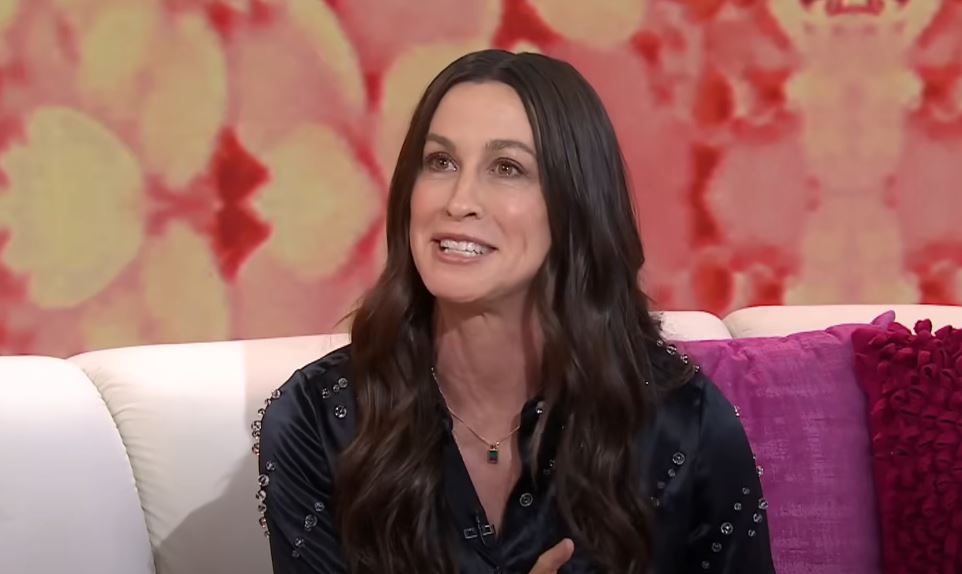The financial success of Alanis Morissette, especially in 2025, is indicative of a career based on more than just award wins and poignant lyrics. Quietly and steadily, she turned a cultural moment of the 1990s into a long-lasting empire. Her estimated net worth of $60 million wasn’t achieved overnight; rather, it was the result of calculated decisions, astute turns, and a voice that never went away.
Alanis earned her spot as one of the most marketable artists in music during the meteoric rise of Jagged Little Pill. Her reputation as an incredibly resilient force in the music industry was cemented when that album alone sold over 33 million copies worldwide. While many artists’ profit margins were reduced in recent years due to streaming, Morissette’s significant publishing and songwriting ownership helped her keep her earnings stable. Her choice to co-write almost all of her songs has been remarkably successful in ensuring that royalties kept coming in.
Alanis Morissette – Bio and Net Worth Summary (2025)
| Full Name | Alanis Nadine Morissette |
|---|---|
| Date of Birth | June 1, 1974 |
| Birthplace | Ottawa, Ontario, Canada |
| Nationality | Canadian, American (since 2005) |
| Occupation | Singer, Songwriter, Actress |
| Spouse | Mario “Souleye” Treadway (m. 2010) |
| Children | 3 |
| Notable Work | Jagged Little Pill (1995), Broadway Musical |
| Total Albums Sold | Over 75 million |
| Estimated Net Worth | $60 million (2025) |
| Revenue Sources | Music royalties, touring, real estate, acting |
She had multiple breakthrough hits that contributed to her success. She was a Canadian teen pop star before she took over American radio. Although they hardly registered abroad, early albums like Alanis and Now Is the Time showed commercial promise in Canada. Her fortunes, however, took a permanent turn after she joined forces with producer Glen Ballard. She produced a sound that spoke to millions of people by working with someone who accepted her emotional rawness instead of removing it.
She has continued to develop over the last 20 years, honing her creative voice rather than following trends. She managed to stay visible even when the focus shifted by carefully reinventing herself. For example, her Broadway version of Jagged Little Pill earned her a Grammy Award for Best Musical Theater Album and a new wave of income. Notably inventive in both concept and execution, that project crossed generations and served as a reminder to listeners of the album’s timeless appeal.
Alanis has also seen financial success with his real estate strategy. She bought her Brentwood home for just $1.8 million in the late 1990s, and in 2017 she sold it for $5.35 million. Her choice to move to Olympic Valley from Los Angeles was in line with an increasing trend among creatives who value their well-being over continual publicity. It also signaled a change in the way that wealth is maintained for celebrities, not only through earnings but also through lifestyle design.
Her legal dispute with former business manager Jonathan Schwartz, who embezzled more than $5 million, was especially noteworthy. Many public figures might be reluctant to publicly address such betrayals, but Alanis stood up for justice and was successful. Despite being emotionally and financially taxing, that experience strengthened her fortitude. It also draws attention to a larger warning to artists who handle their newfound wealth carelessly.
She has been remarkably outspoken about mental health, a subject that has shaped both her public persona and personal development. Morissette has opened up to her fans about her past battles with eating disorders and postpartum depression, allowing them to enter a place of authenticity and healing. She released The Storm Before the Calm, a meditation album intended to calm rather than sell, during the pandemic, using her platform for introspection rather than promotion. That move was particularly appropriate and very adaptable, demonstrating her range as an artist and her emotional maturity.
Examining her songwriting makes the relationship between her development as a person and her work especially evident. She has never held back when sharing her loss, thankfulness, or personal development, and this openness has not only cultivated a following but also a devoted community. Alanis stands out in a time when filters and staged interviews are commonplace because of her refreshing candor.
Although her relationships have frequently made headlines, especially those with rapper Souleye (her husband since 2010) and actor Ryan Reynolds in the early 2000s, she has been able to strike a healthy balance between her private life and her celebrity. Despite not being surrounded by the usual glitz and glamour of the industry, her marriage has quietly flourished, demonstrating a solid foundation that is reflected in her work life. The three kids of the couple are currently growing up in a mountain town that is very different from the bustle of Hollywood.
Alanis provides a remarkably clear blueprint for aspiring artists. Keep control over your music, make sensible real estate investments, broaden your creative horizons, and don’t be scared to change. She is a sustainability case study in addition to being a 1990s alt-rock icon. Her wealth is a reflection of her long-term planning, emotional authenticity, and fierce independence in addition to the money she makes from performances or album sales.

